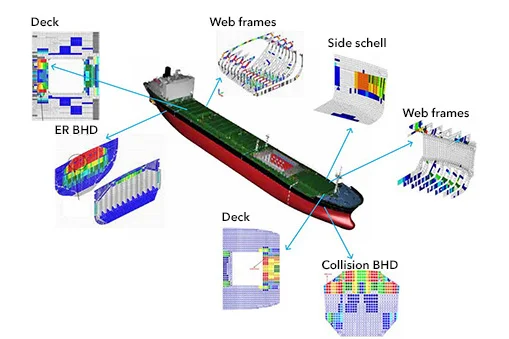In shipbuilding, the term “scantling” refers to the dimensions of the structural elements that make up the hull of a ship, excluding the keel. It encompasses the framing, girders, stiffeners, and plates, which are attached to form the hull.
The purpose of the scantling is to provide the necessary strength and stability to the ship’s structure to withstand the stresses of navigation and ensure the safety of the crew and cargo.

Scantlings are an essential part of ship design, and their size and strength are determined based on the ship’s intended use and the classification society’s rules and regulations.
Classification societies, such as the American Bureau of Shipping (ABS) and Lloyd’s Register, provide guidelines on the minimum scantling requirements for different types of vessels, based on their size, type, and service.
The scantling of a ship’s hull is usually measured in cross-sectional areas, and the dimensions of the structural elements are expressed in terms of their depth, breadth, and thickness. For instance, a common way to describe the scantling of a frame is by its section modulus, which is the measure of its resistance to bending.
The section modulus is calculated by dividing the moment of inertia of the cross-section by the distance from the neutral axis to the most extreme fiber.
The scantling length refers to the structural length of a ship and is also taken into account when determining the size and strength of the structural elements. The length of the hull determines the number and spacing of the frames and the thickness of the plating.
Reduced scantlings are allowed when approved corrosion control arrangements have been applied. Corrosion is a significant threat to the structural integrity of a ship, and corrosion control measures, such as coating and cathodic protection, are essential to prevent metal loss and maintain the strength of the scantlings.
A “full scantling vessel” is a ship that can reach all parts of its cargo spaces with its own gear, such as cranes and winches. This term is commonly used in shipping to differentiate between vessels that require external assistance to load and unload their cargo and those that can do it independently.
In summary, the scantling of a ship’s hull is the collective dimensions of the framing, girders, stiffeners, and plates that provide the necessary strength and stability to the ship’s structure. The size and strength of the scantlings are determined based on the ship’s intended use and the classification society’s rules and regulations, and reduced scantlings are allowed when approved corrosion control measures have been applied.



